Sustainable Engineering Practices for a Better Environment
VerifiedAdded on 2023/04/19
|11
|2417
|99
Report
AI Summary
This report provides a comprehensive overview of sustainable engineering practices, emphasizing their significance in environmental management. It explores the application of sustainable principles, highlighting the importance of maintaining sustainability through various engineering practices. The report discusses the challenges in implementing sustainable engineering, such as the need for new technologies and expert knowledge, and proposes future developments like design thinking. It covers topics including asset management, renewable energy, and the economic benefits of sustainable practices, offering insights into how these practices can reduce pollution, conserve resources, and contribute to a better environment. The report also addresses the integration of sustainable practices in mechanical, electrical, and information technology engineering, showcasing how these principles can be applied to create cost-effective and environmentally friendly solutions. The report concludes that sustainable engineering practices are vital for ensuring a better future for all.
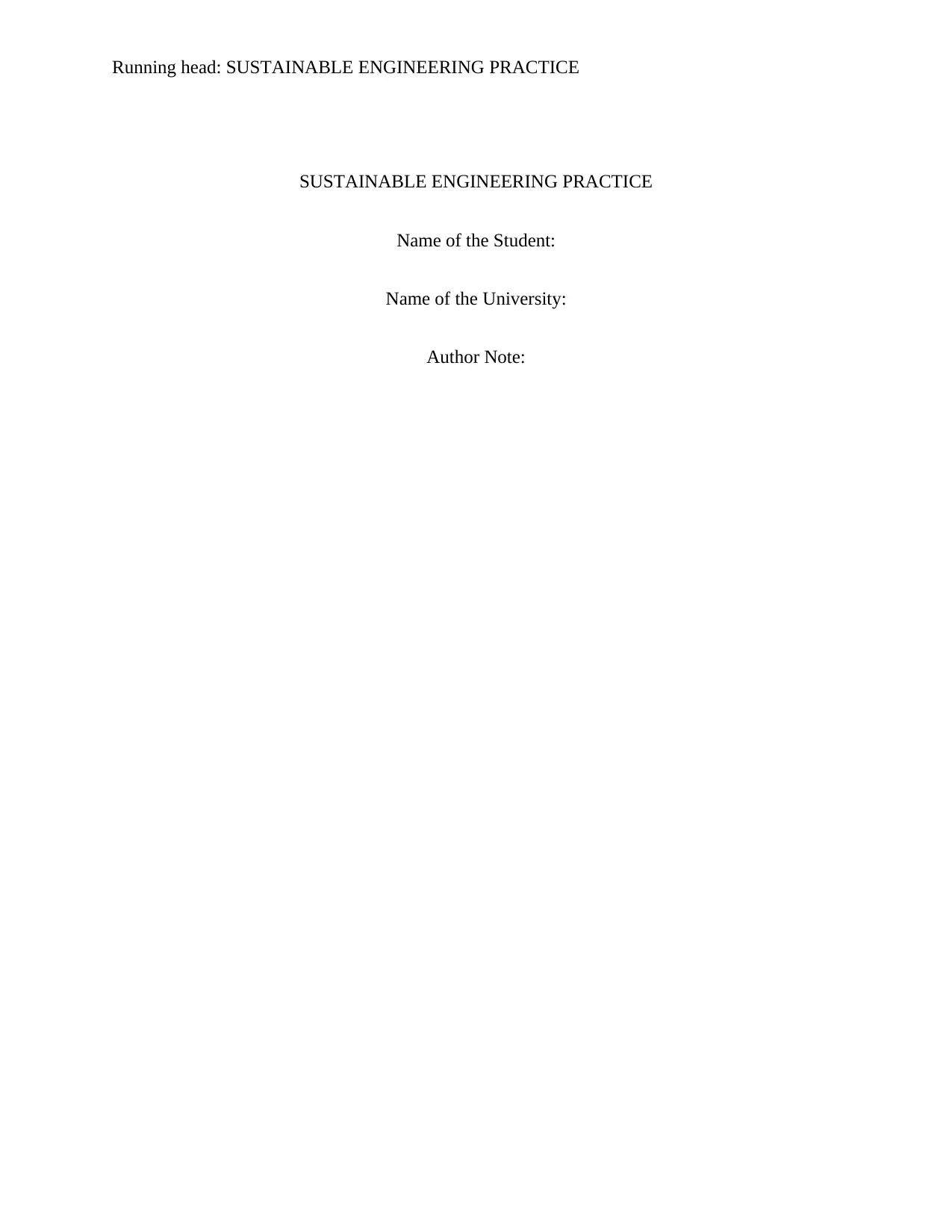
Running head: SUSTAINABLE ENGINEERING PRACTICE
SUSTAINABLE ENGINEERING PRACTICE
Name of the Student:
Name of the University:
Author Note:
SUSTAINABLE ENGINEERING PRACTICE
Name of the Student:
Name of the University:
Author Note:
Paraphrase This Document
Need a fresh take? Get an instant paraphrase of this document with our AI Paraphraser
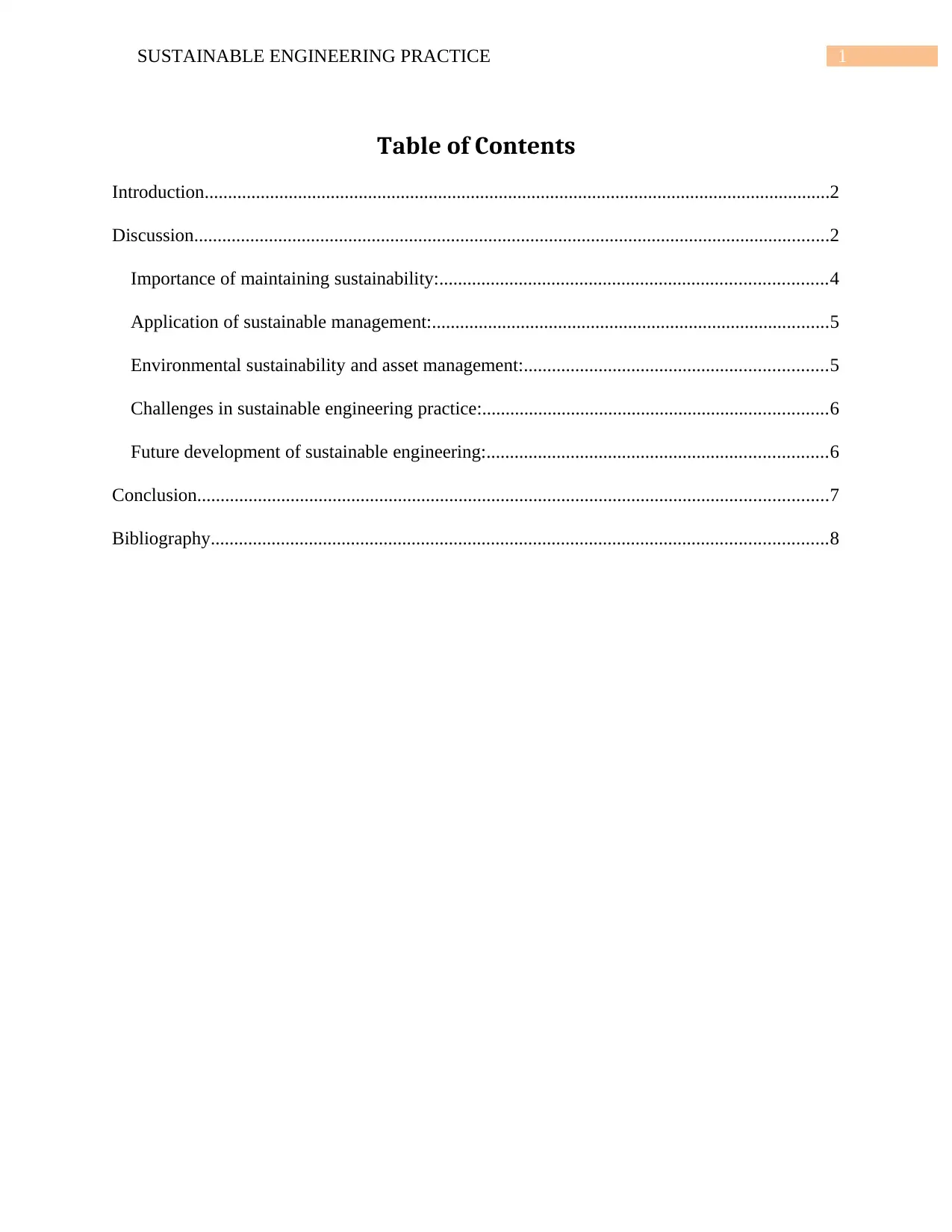
1SUSTAINABLE ENGINEERING PRACTICE
Table of Contents
Introduction......................................................................................................................................2
Discussion........................................................................................................................................2
Importance of maintaining sustainability:...................................................................................4
Application of sustainable management:.....................................................................................5
Environmental sustainability and asset management:.................................................................5
Challenges in sustainable engineering practice:..........................................................................6
Future development of sustainable engineering:.........................................................................6
Conclusion.......................................................................................................................................7
Bibliography....................................................................................................................................8
Table of Contents
Introduction......................................................................................................................................2
Discussion........................................................................................................................................2
Importance of maintaining sustainability:...................................................................................4
Application of sustainable management:.....................................................................................5
Environmental sustainability and asset management:.................................................................5
Challenges in sustainable engineering practice:..........................................................................6
Future development of sustainable engineering:.........................................................................6
Conclusion.......................................................................................................................................7
Bibliography....................................................................................................................................8
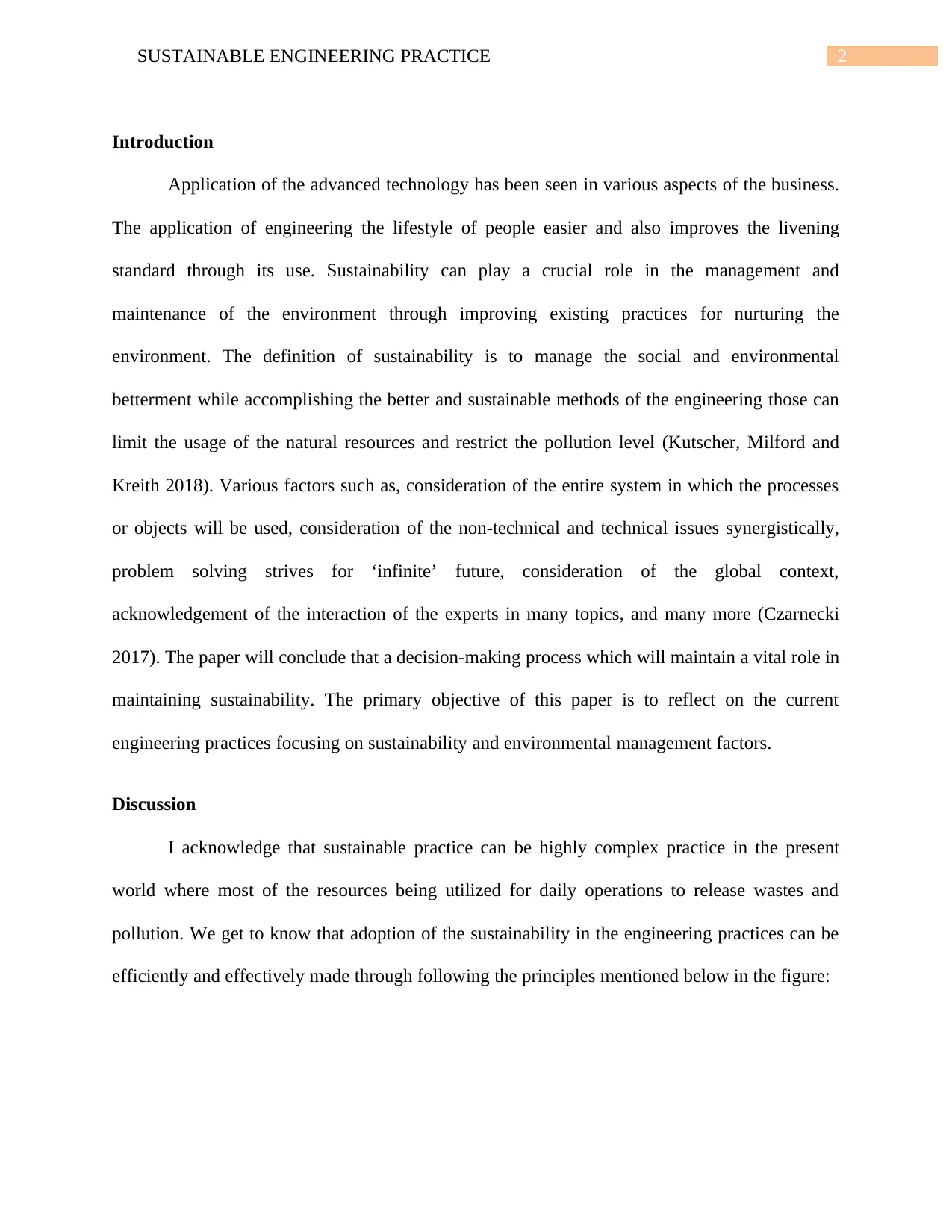
2SUSTAINABLE ENGINEERING PRACTICE
Introduction
Application of the advanced technology has been seen in various aspects of the business.
The application of engineering the lifestyle of people easier and also improves the livening
standard through its use. Sustainability can play a crucial role in the management and
maintenance of the environment through improving existing practices for nurturing the
environment. The definition of sustainability is to manage the social and environmental
betterment while accomplishing the better and sustainable methods of the engineering those can
limit the usage of the natural resources and restrict the pollution level (Kutscher, Milford and
Kreith 2018). Various factors such as, consideration of the entire system in which the processes
or objects will be used, consideration of the non-technical and technical issues synergistically,
problem solving strives for ‘infinite’ future, consideration of the global context,
acknowledgement of the interaction of the experts in many topics, and many more (Czarnecki
2017). The paper will conclude that a decision-making process which will maintain a vital role in
maintaining sustainability. The primary objective of this paper is to reflect on the current
engineering practices focusing on sustainability and environmental management factors.
Discussion
I acknowledge that sustainable practice can be highly complex practice in the present
world where most of the resources being utilized for daily operations to release wastes and
pollution. We get to know that adoption of the sustainability in the engineering practices can be
efficiently and effectively made through following the principles mentioned below in the figure:
Introduction
Application of the advanced technology has been seen in various aspects of the business.
The application of engineering the lifestyle of people easier and also improves the livening
standard through its use. Sustainability can play a crucial role in the management and
maintenance of the environment through improving existing practices for nurturing the
environment. The definition of sustainability is to manage the social and environmental
betterment while accomplishing the better and sustainable methods of the engineering those can
limit the usage of the natural resources and restrict the pollution level (Kutscher, Milford and
Kreith 2018). Various factors such as, consideration of the entire system in which the processes
or objects will be used, consideration of the non-technical and technical issues synergistically,
problem solving strives for ‘infinite’ future, consideration of the global context,
acknowledgement of the interaction of the experts in many topics, and many more (Czarnecki
2017). The paper will conclude that a decision-making process which will maintain a vital role in
maintaining sustainability. The primary objective of this paper is to reflect on the current
engineering practices focusing on sustainability and environmental management factors.
Discussion
I acknowledge that sustainable practice can be highly complex practice in the present
world where most of the resources being utilized for daily operations to release wastes and
pollution. We get to know that adoption of the sustainability in the engineering practices can be
efficiently and effectively made through following the principles mentioned below in the figure:
⊘ This is a preview!⊘
Do you want full access?
Subscribe today to unlock all pages.

Trusted by 1+ million students worldwide
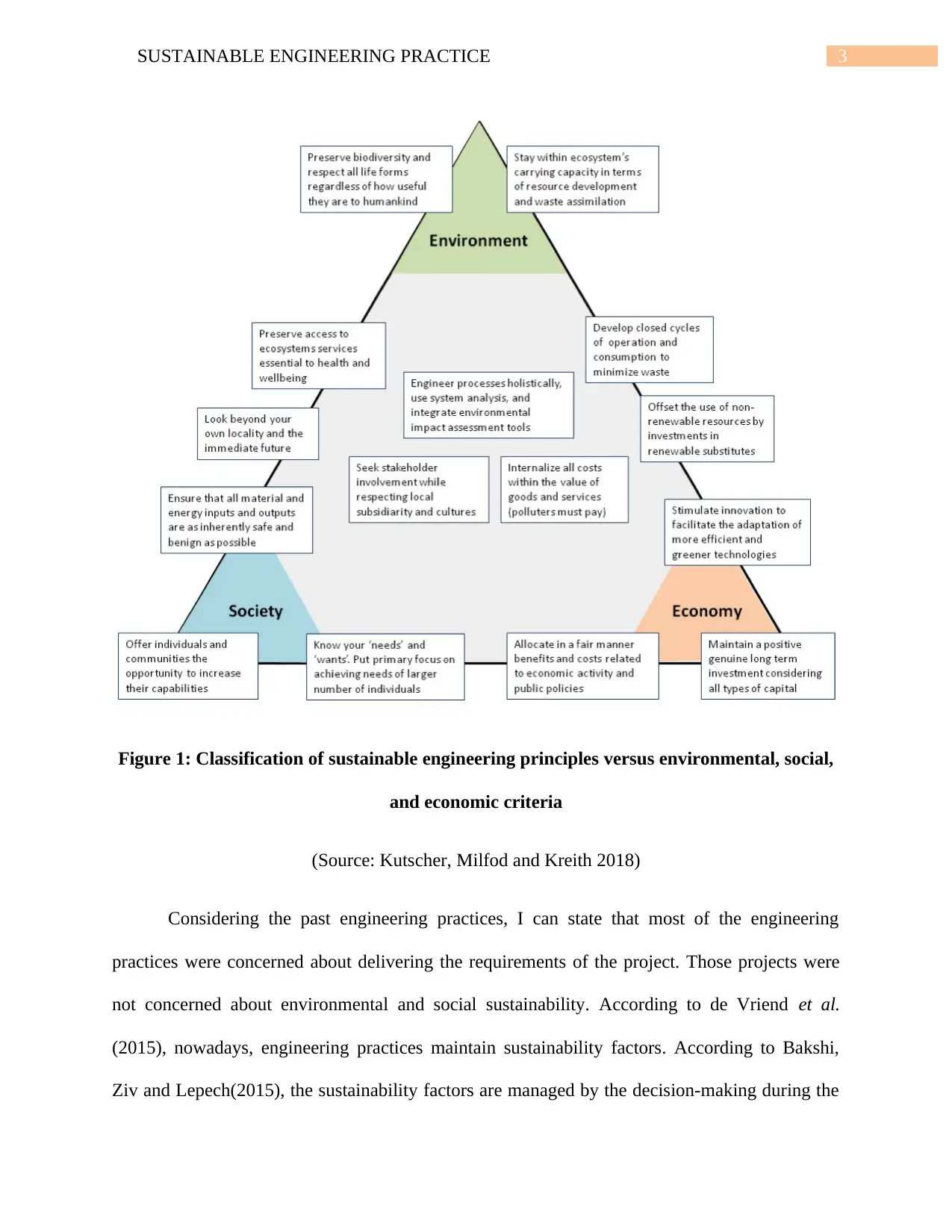
3SUSTAINABLE ENGINEERING PRACTICE
Figure 1: Classification of sustainable engineering principles versus environmental, social,
and economic criteria
(Source: Kutscher, Milfod and Kreith 2018)
Considering the past engineering practices, I can state that most of the engineering
practices were concerned about delivering the requirements of the project. Those projects were
not concerned about environmental and social sustainability. According to de Vriend et al.
(2015), nowadays, engineering practices maintain sustainability factors. According to Bakshi,
Ziv and Lepech(2015), the sustainability factors are managed by the decision-making during the
Figure 1: Classification of sustainable engineering principles versus environmental, social,
and economic criteria
(Source: Kutscher, Milfod and Kreith 2018)
Considering the past engineering practices, I can state that most of the engineering
practices were concerned about delivering the requirements of the project. Those projects were
not concerned about environmental and social sustainability. According to de Vriend et al.
(2015), nowadays, engineering practices maintain sustainability factors. According to Bakshi,
Ziv and Lepech(2015), the sustainability factors are managed by the decision-making during the
Paraphrase This Document
Need a fresh take? Get an instant paraphrase of this document with our AI Paraphraser
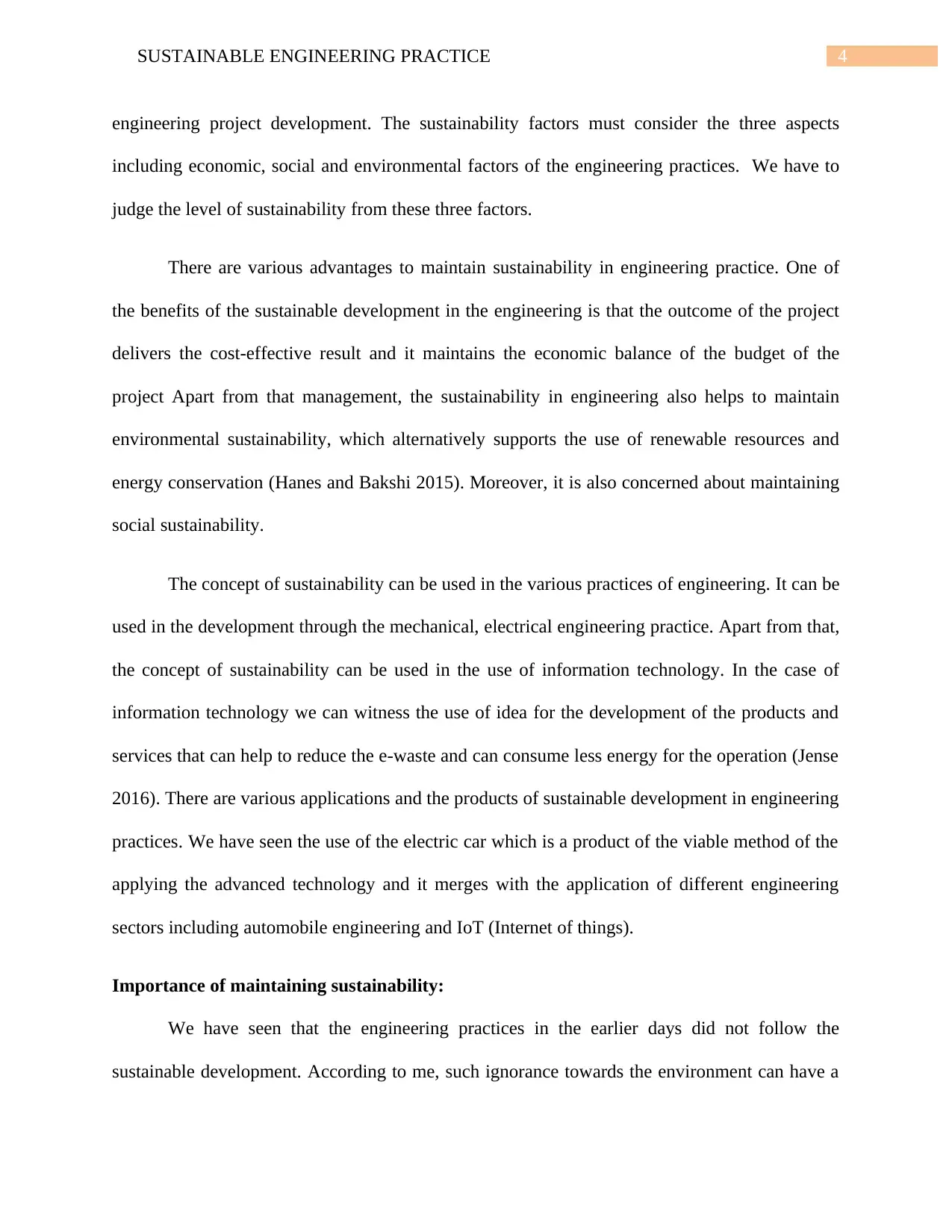
4SUSTAINABLE ENGINEERING PRACTICE
engineering project development. The sustainability factors must consider the three aspects
including economic, social and environmental factors of the engineering practices. We have to
judge the level of sustainability from these three factors.
There are various advantages to maintain sustainability in engineering practice. One of
the benefits of the sustainable development in the engineering is that the outcome of the project
delivers the cost-effective result and it maintains the economic balance of the budget of the
project Apart from that management, the sustainability in engineering also helps to maintain
environmental sustainability, which alternatively supports the use of renewable resources and
energy conservation (Hanes and Bakshi 2015). Moreover, it is also concerned about maintaining
social sustainability.
The concept of sustainability can be used in the various practices of engineering. It can be
used in the development through the mechanical, electrical engineering practice. Apart from that,
the concept of sustainability can be used in the use of information technology. In the case of
information technology we can witness the use of idea for the development of the products and
services that can help to reduce the e-waste and can consume less energy for the operation (Jense
2016). There are various applications and the products of sustainable development in engineering
practices. We have seen the use of the electric car which is a product of the viable method of the
applying the advanced technology and it merges with the application of different engineering
sectors including automobile engineering and IoT (Internet of things).
Importance of maintaining sustainability:
We have seen that the engineering practices in the earlier days did not follow the
sustainable development. According to me, such ignorance towards the environment can have a
engineering project development. The sustainability factors must consider the three aspects
including economic, social and environmental factors of the engineering practices. We have to
judge the level of sustainability from these three factors.
There are various advantages to maintain sustainability in engineering practice. One of
the benefits of the sustainable development in the engineering is that the outcome of the project
delivers the cost-effective result and it maintains the economic balance of the budget of the
project Apart from that management, the sustainability in engineering also helps to maintain
environmental sustainability, which alternatively supports the use of renewable resources and
energy conservation (Hanes and Bakshi 2015). Moreover, it is also concerned about maintaining
social sustainability.
The concept of sustainability can be used in the various practices of engineering. It can be
used in the development through the mechanical, electrical engineering practice. Apart from that,
the concept of sustainability can be used in the use of information technology. In the case of
information technology we can witness the use of idea for the development of the products and
services that can help to reduce the e-waste and can consume less energy for the operation (Jense
2016). There are various applications and the products of sustainable development in engineering
practices. We have seen the use of the electric car which is a product of the viable method of the
applying the advanced technology and it merges with the application of different engineering
sectors including automobile engineering and IoT (Internet of things).
Importance of maintaining sustainability:
We have seen that the engineering practices in the earlier days did not follow the
sustainable development. According to me, such ignorance towards the environment can have a
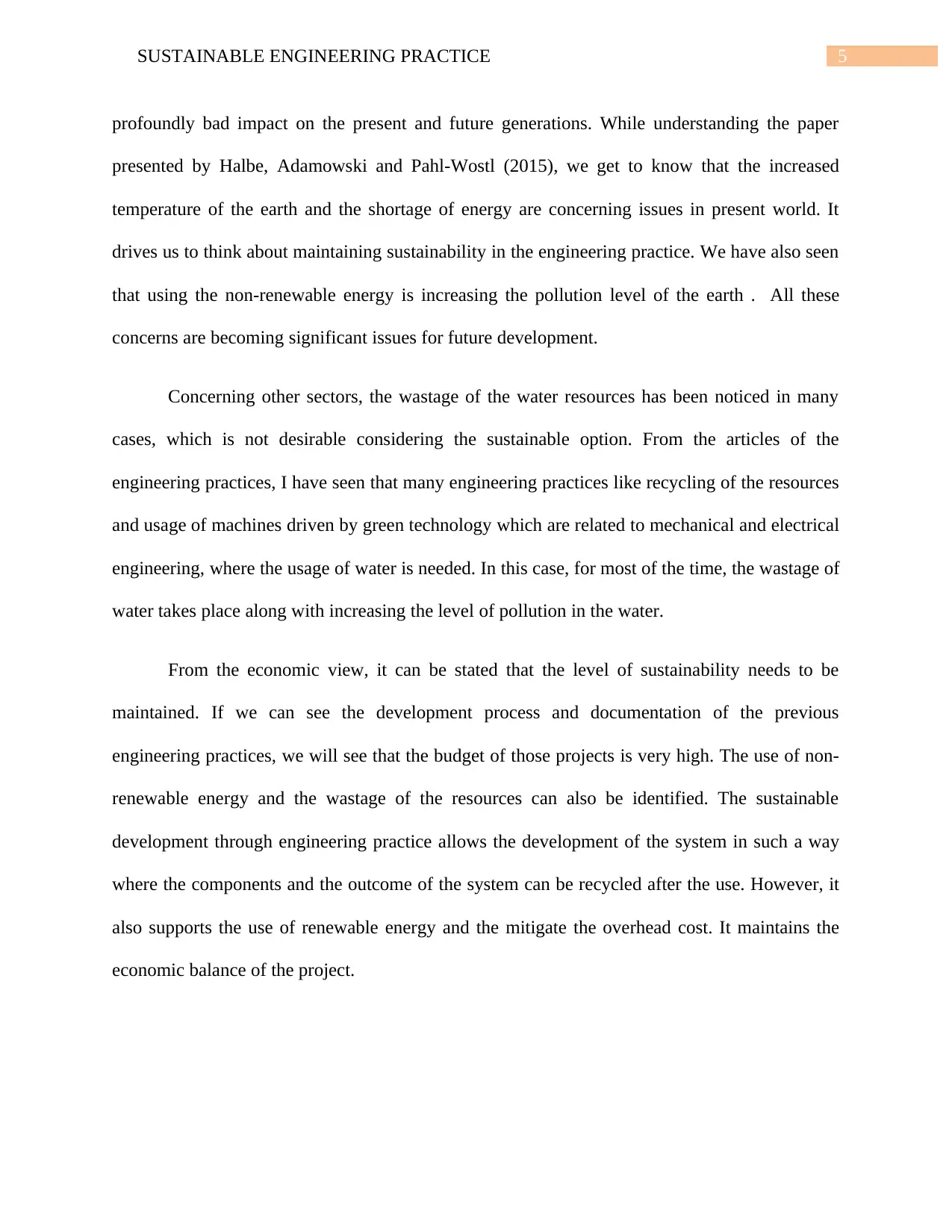
5SUSTAINABLE ENGINEERING PRACTICE
profoundly bad impact on the present and future generations. While understanding the paper
presented by Halbe, Adamowski and Pahl-Wostl (2015), we get to know that the increased
temperature of the earth and the shortage of energy are concerning issues in present world. It
drives us to think about maintaining sustainability in the engineering practice. We have also seen
that using the non-renewable energy is increasing the pollution level of the earth . All these
concerns are becoming significant issues for future development.
Concerning other sectors, the wastage of the water resources has been noticed in many
cases, which is not desirable considering the sustainable option. From the articles of the
engineering practices, I have seen that many engineering practices like recycling of the resources
and usage of machines driven by green technology which are related to mechanical and electrical
engineering, where the usage of water is needed. In this case, for most of the time, the wastage of
water takes place along with increasing the level of pollution in the water.
From the economic view, it can be stated that the level of sustainability needs to be
maintained. If we can see the development process and documentation of the previous
engineering practices, we will see that the budget of those projects is very high. The use of non-
renewable energy and the wastage of the resources can also be identified. The sustainable
development through engineering practice allows the development of the system in such a way
where the components and the outcome of the system can be recycled after the use. However, it
also supports the use of renewable energy and the mitigate the overhead cost. It maintains the
economic balance of the project.
profoundly bad impact on the present and future generations. While understanding the paper
presented by Halbe, Adamowski and Pahl-Wostl (2015), we get to know that the increased
temperature of the earth and the shortage of energy are concerning issues in present world. It
drives us to think about maintaining sustainability in the engineering practice. We have also seen
that using the non-renewable energy is increasing the pollution level of the earth . All these
concerns are becoming significant issues for future development.
Concerning other sectors, the wastage of the water resources has been noticed in many
cases, which is not desirable considering the sustainable option. From the articles of the
engineering practices, I have seen that many engineering practices like recycling of the resources
and usage of machines driven by green technology which are related to mechanical and electrical
engineering, where the usage of water is needed. In this case, for most of the time, the wastage of
water takes place along with increasing the level of pollution in the water.
From the economic view, it can be stated that the level of sustainability needs to be
maintained. If we can see the development process and documentation of the previous
engineering practices, we will see that the budget of those projects is very high. The use of non-
renewable energy and the wastage of the resources can also be identified. The sustainable
development through engineering practice allows the development of the system in such a way
where the components and the outcome of the system can be recycled after the use. However, it
also supports the use of renewable energy and the mitigate the overhead cost. It maintains the
economic balance of the project.
⊘ This is a preview!⊘
Do you want full access?
Subscribe today to unlock all pages.

Trusted by 1+ million students worldwide
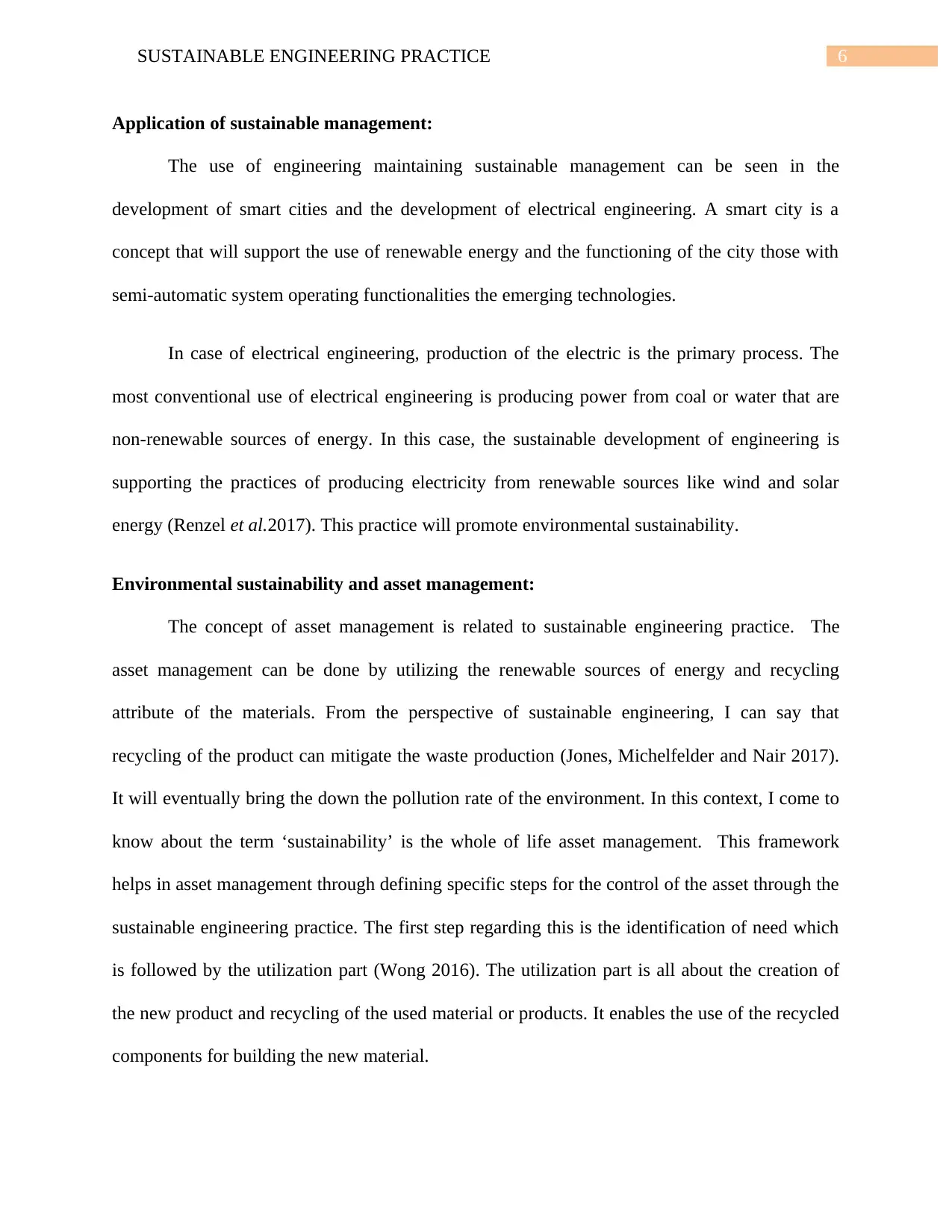
6SUSTAINABLE ENGINEERING PRACTICE
Application of sustainable management:
The use of engineering maintaining sustainable management can be seen in the
development of smart cities and the development of electrical engineering. A smart city is a
concept that will support the use of renewable energy and the functioning of the city those with
semi-automatic system operating functionalities the emerging technologies.
In case of electrical engineering, production of the electric is the primary process. The
most conventional use of electrical engineering is producing power from coal or water that are
non-renewable sources of energy. In this case, the sustainable development of engineering is
supporting the practices of producing electricity from renewable sources like wind and solar
energy (Renzel et al.2017). This practice will promote environmental sustainability.
Environmental sustainability and asset management:
The concept of asset management is related to sustainable engineering practice. The
asset management can be done by utilizing the renewable sources of energy and recycling
attribute of the materials. From the perspective of sustainable engineering, I can say that
recycling of the product can mitigate the waste production (Jones, Michelfelder and Nair 2017).
It will eventually bring the down the pollution rate of the environment. In this context, I come to
know about the term ‘sustainability’ is the whole of life asset management. This framework
helps in asset management through defining specific steps for the control of the asset through the
sustainable engineering practice. The first step regarding this is the identification of need which
is followed by the utilization part (Wong 2016). The utilization part is all about the creation of
the new product and recycling of the used material or products. It enables the use of the recycled
components for building the new material.
Application of sustainable management:
The use of engineering maintaining sustainable management can be seen in the
development of smart cities and the development of electrical engineering. A smart city is a
concept that will support the use of renewable energy and the functioning of the city those with
semi-automatic system operating functionalities the emerging technologies.
In case of electrical engineering, production of the electric is the primary process. The
most conventional use of electrical engineering is producing power from coal or water that are
non-renewable sources of energy. In this case, the sustainable development of engineering is
supporting the practices of producing electricity from renewable sources like wind and solar
energy (Renzel et al.2017). This practice will promote environmental sustainability.
Environmental sustainability and asset management:
The concept of asset management is related to sustainable engineering practice. The
asset management can be done by utilizing the renewable sources of energy and recycling
attribute of the materials. From the perspective of sustainable engineering, I can say that
recycling of the product can mitigate the waste production (Jones, Michelfelder and Nair 2017).
It will eventually bring the down the pollution rate of the environment. In this context, I come to
know about the term ‘sustainability’ is the whole of life asset management. This framework
helps in asset management through defining specific steps for the control of the asset through the
sustainable engineering practice. The first step regarding this is the identification of need which
is followed by the utilization part (Wong 2016). The utilization part is all about the creation of
the new product and recycling of the used material or products. It enables the use of the recycled
components for building the new material.
Paraphrase This Document
Need a fresh take? Get an instant paraphrase of this document with our AI Paraphraser
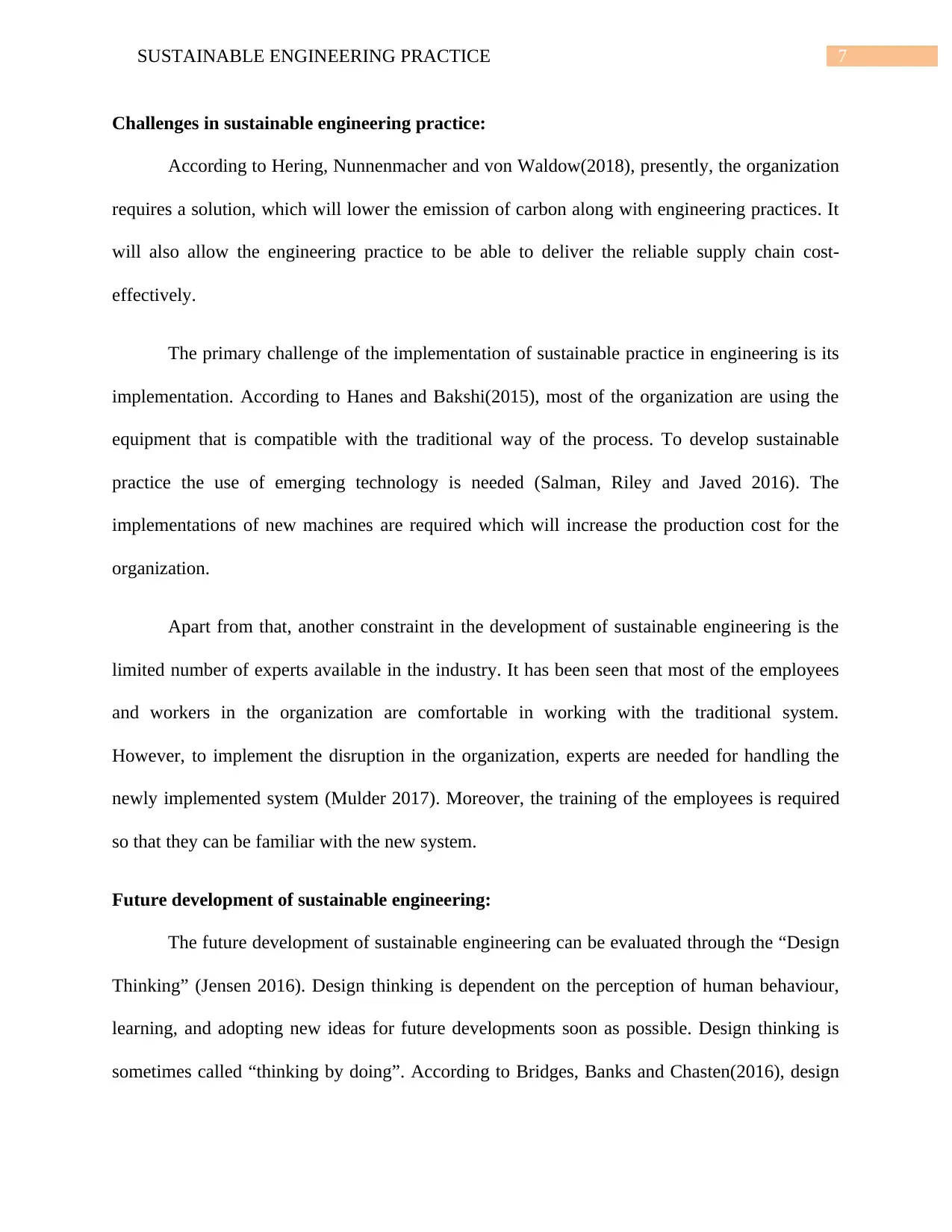
7SUSTAINABLE ENGINEERING PRACTICE
Challenges in sustainable engineering practice:
According to Hering, Nunnenmacher and von Waldow(2018), presently, the organization
requires a solution, which will lower the emission of carbon along with engineering practices. It
will also allow the engineering practice to be able to deliver the reliable supply chain cost-
effectively.
The primary challenge of the implementation of sustainable practice in engineering is its
implementation. According to Hanes and Bakshi(2015), most of the organization are using the
equipment that is compatible with the traditional way of the process. To develop sustainable
practice the use of emerging technology is needed (Salman, Riley and Javed 2016). The
implementations of new machines are required which will increase the production cost for the
organization.
Apart from that, another constraint in the development of sustainable engineering is the
limited number of experts available in the industry. It has been seen that most of the employees
and workers in the organization are comfortable in working with the traditional system.
However, to implement the disruption in the organization, experts are needed for handling the
newly implemented system (Mulder 2017). Moreover, the training of the employees is required
so that they can be familiar with the new system.
Future development of sustainable engineering:
The future development of sustainable engineering can be evaluated through the “Design
Thinking” (Jensen 2016). Design thinking is dependent on the perception of human behaviour,
learning, and adopting new ideas for future developments soon as possible. Design thinking is
sometimes called “thinking by doing”. According to Bridges, Banks and Chasten(2016), design
Challenges in sustainable engineering practice:
According to Hering, Nunnenmacher and von Waldow(2018), presently, the organization
requires a solution, which will lower the emission of carbon along with engineering practices. It
will also allow the engineering practice to be able to deliver the reliable supply chain cost-
effectively.
The primary challenge of the implementation of sustainable practice in engineering is its
implementation. According to Hanes and Bakshi(2015), most of the organization are using the
equipment that is compatible with the traditional way of the process. To develop sustainable
practice the use of emerging technology is needed (Salman, Riley and Javed 2016). The
implementations of new machines are required which will increase the production cost for the
organization.
Apart from that, another constraint in the development of sustainable engineering is the
limited number of experts available in the industry. It has been seen that most of the employees
and workers in the organization are comfortable in working with the traditional system.
However, to implement the disruption in the organization, experts are needed for handling the
newly implemented system (Mulder 2017). Moreover, the training of the employees is required
so that they can be familiar with the new system.
Future development of sustainable engineering:
The future development of sustainable engineering can be evaluated through the “Design
Thinking” (Jensen 2016). Design thinking is dependent on the perception of human behaviour,
learning, and adopting new ideas for future developments soon as possible. Design thinking is
sometimes called “thinking by doing”. According to Bridges, Banks and Chasten(2016), design
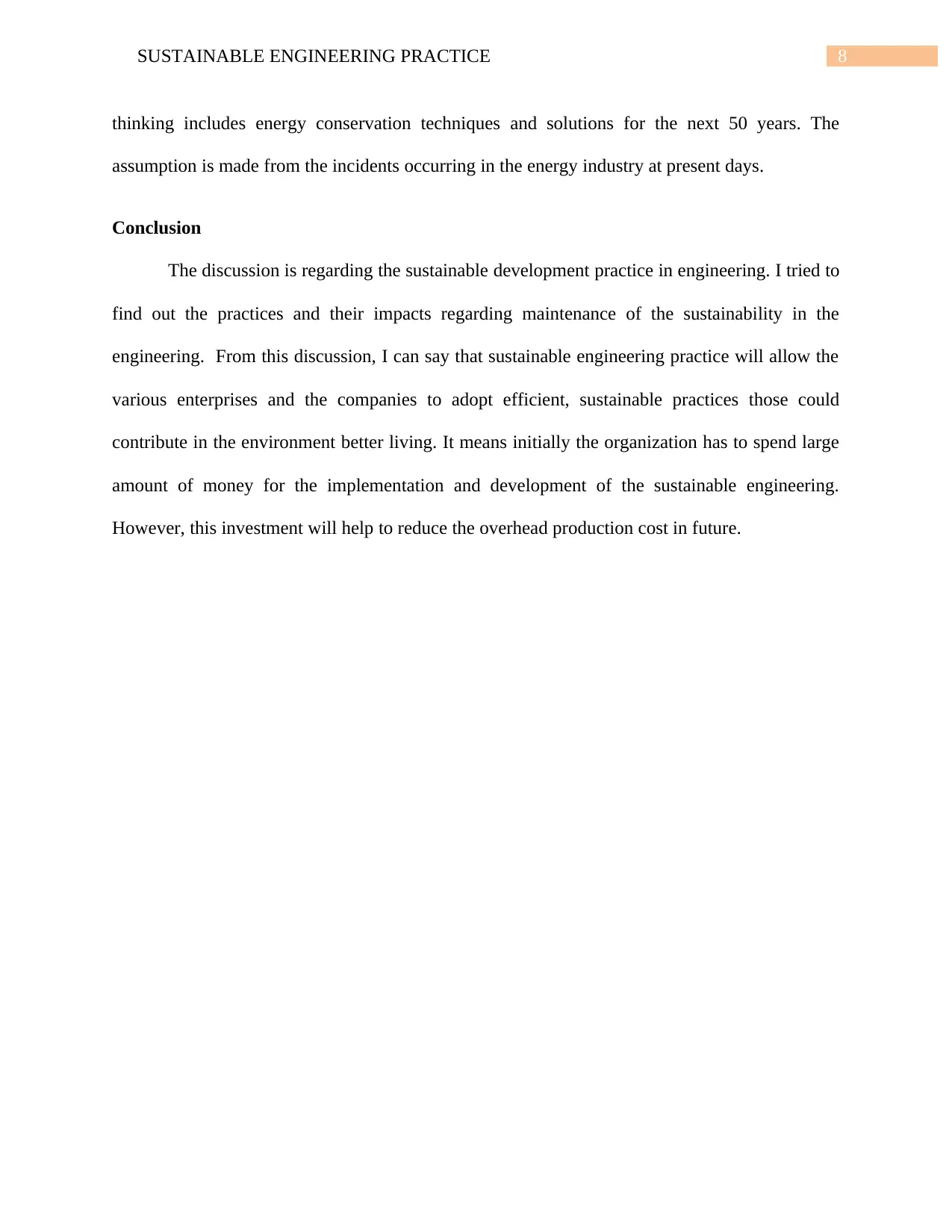
8SUSTAINABLE ENGINEERING PRACTICE
thinking includes energy conservation techniques and solutions for the next 50 years. The
assumption is made from the incidents occurring in the energy industry at present days.
Conclusion
The discussion is regarding the sustainable development practice in engineering. I tried to
find out the practices and their impacts regarding maintenance of the sustainability in the
engineering. From this discussion, I can say that sustainable engineering practice will allow the
various enterprises and the companies to adopt efficient, sustainable practices those could
contribute in the environment better living. It means initially the organization has to spend large
amount of money for the implementation and development of the sustainable engineering.
However, this investment will help to reduce the overhead production cost in future.
thinking includes energy conservation techniques and solutions for the next 50 years. The
assumption is made from the incidents occurring in the energy industry at present days.
Conclusion
The discussion is regarding the sustainable development practice in engineering. I tried to
find out the practices and their impacts regarding maintenance of the sustainability in the
engineering. From this discussion, I can say that sustainable engineering practice will allow the
various enterprises and the companies to adopt efficient, sustainable practices those could
contribute in the environment better living. It means initially the organization has to spend large
amount of money for the implementation and development of the sustainable engineering.
However, this investment will help to reduce the overhead production cost in future.
⊘ This is a preview!⊘
Do you want full access?
Subscribe today to unlock all pages.

Trusted by 1+ million students worldwide
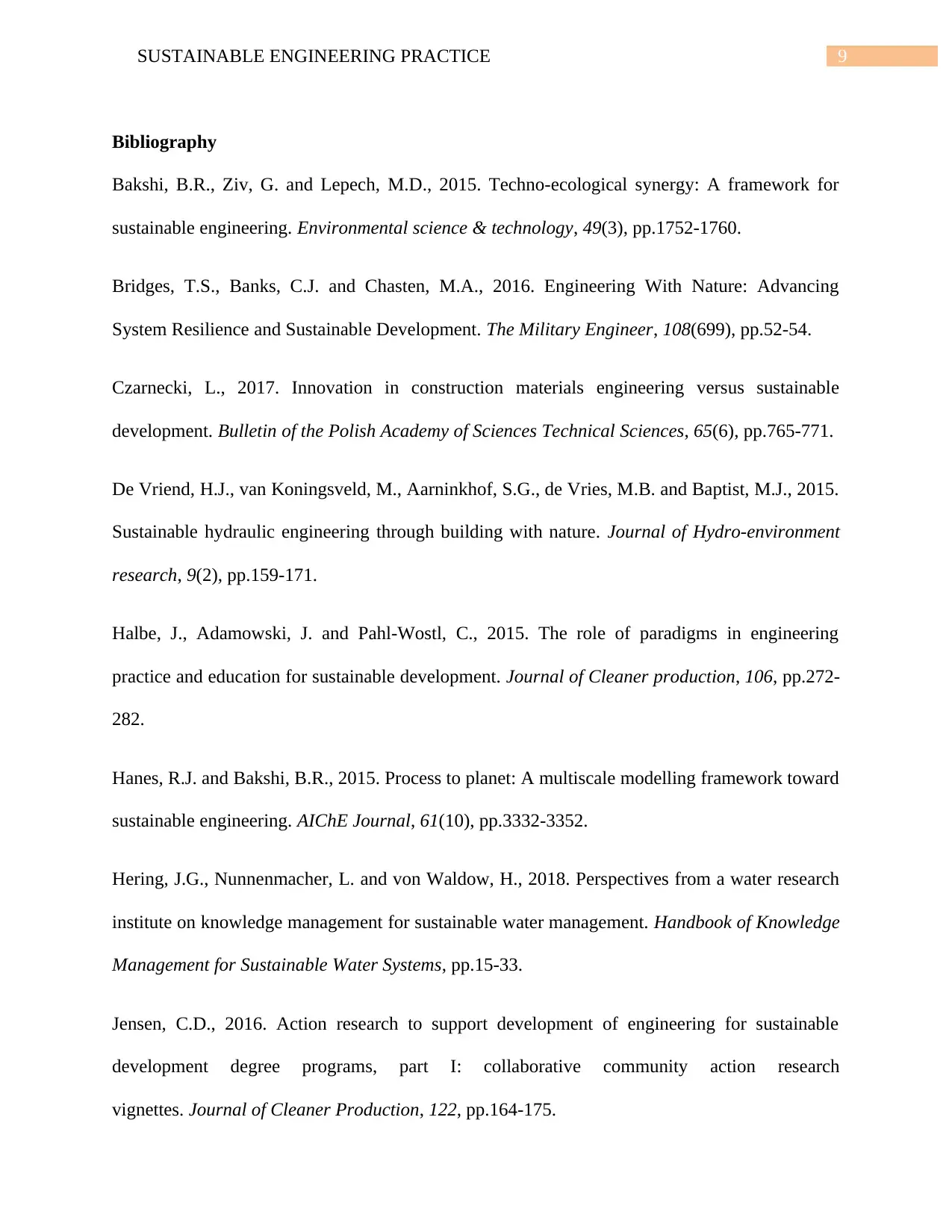
9SUSTAINABLE ENGINEERING PRACTICE
Bibliography
Bakshi, B.R., Ziv, G. and Lepech, M.D., 2015. Techno-ecological synergy: A framework for
sustainable engineering. Environmental science & technology, 49(3), pp.1752-1760.
Bridges, T.S., Banks, C.J. and Chasten, M.A., 2016. Engineering With Nature: Advancing
System Resilience and Sustainable Development. The Military Engineer, 108(699), pp.52-54.
Czarnecki, L., 2017. Innovation in construction materials engineering versus sustainable
development. Bulletin of the Polish Academy of Sciences Technical Sciences, 65(6), pp.765-771.
De Vriend, H.J., van Koningsveld, M., Aarninkhof, S.G., de Vries, M.B. and Baptist, M.J., 2015.
Sustainable hydraulic engineering through building with nature. Journal of Hydro-environment
research, 9(2), pp.159-171.
Halbe, J., Adamowski, J. and Pahl-Wostl, C., 2015. The role of paradigms in engineering
practice and education for sustainable development. Journal of Cleaner production, 106, pp.272-
282.
Hanes, R.J. and Bakshi, B.R., 2015. Process to planet: A multiscale modelling framework toward
sustainable engineering. AIChE Journal, 61(10), pp.3332-3352.
Hering, J.G., Nunnenmacher, L. and von Waldow, H., 2018. Perspectives from a water research
institute on knowledge management for sustainable water management. Handbook of Knowledge
Management for Sustainable Water Systems, pp.15-33.
Jensen, C.D., 2016. Action research to support development of engineering for sustainable
development degree programs, part I: collaborative community action research
vignettes. Journal of Cleaner Production, 122, pp.164-175.
Bibliography
Bakshi, B.R., Ziv, G. and Lepech, M.D., 2015. Techno-ecological synergy: A framework for
sustainable engineering. Environmental science & technology, 49(3), pp.1752-1760.
Bridges, T.S., Banks, C.J. and Chasten, M.A., 2016. Engineering With Nature: Advancing
System Resilience and Sustainable Development. The Military Engineer, 108(699), pp.52-54.
Czarnecki, L., 2017. Innovation in construction materials engineering versus sustainable
development. Bulletin of the Polish Academy of Sciences Technical Sciences, 65(6), pp.765-771.
De Vriend, H.J., van Koningsveld, M., Aarninkhof, S.G., de Vries, M.B. and Baptist, M.J., 2015.
Sustainable hydraulic engineering through building with nature. Journal of Hydro-environment
research, 9(2), pp.159-171.
Halbe, J., Adamowski, J. and Pahl-Wostl, C., 2015. The role of paradigms in engineering
practice and education for sustainable development. Journal of Cleaner production, 106, pp.272-
282.
Hanes, R.J. and Bakshi, B.R., 2015. Process to planet: A multiscale modelling framework toward
sustainable engineering. AIChE Journal, 61(10), pp.3332-3352.
Hering, J.G., Nunnenmacher, L. and von Waldow, H., 2018. Perspectives from a water research
institute on knowledge management for sustainable water management. Handbook of Knowledge
Management for Sustainable Water Systems, pp.15-33.
Jensen, C.D., 2016. Action research to support development of engineering for sustainable
development degree programs, part I: collaborative community action research
vignettes. Journal of Cleaner Production, 122, pp.164-175.
Paraphrase This Document
Need a fresh take? Get an instant paraphrase of this document with our AI Paraphraser
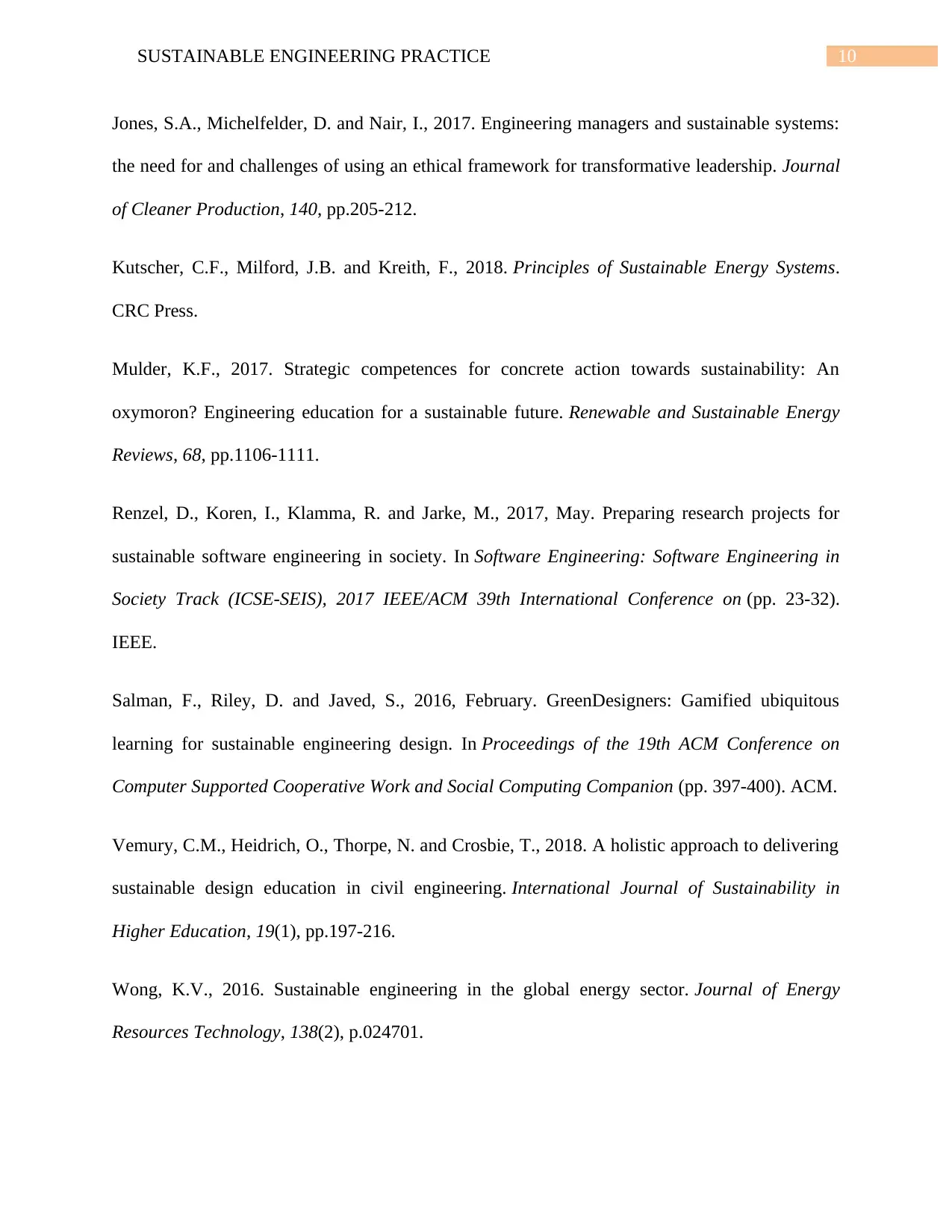
10SUSTAINABLE ENGINEERING PRACTICE
Jones, S.A., Michelfelder, D. and Nair, I., 2017. Engineering managers and sustainable systems:
the need for and challenges of using an ethical framework for transformative leadership. Journal
of Cleaner Production, 140, pp.205-212.
Kutscher, C.F., Milford, J.B. and Kreith, F., 2018. Principles of Sustainable Energy Systems.
CRC Press.
Mulder, K.F., 2017. Strategic competences for concrete action towards sustainability: An
oxymoron? Engineering education for a sustainable future. Renewable and Sustainable Energy
Reviews, 68, pp.1106-1111.
Renzel, D., Koren, I., Klamma, R. and Jarke, M., 2017, May. Preparing research projects for
sustainable software engineering in society. In Software Engineering: Software Engineering in
Society Track (ICSE-SEIS), 2017 IEEE/ACM 39th International Conference on (pp. 23-32).
IEEE.
Salman, F., Riley, D. and Javed, S., 2016, February. GreenDesigners: Gamified ubiquitous
learning for sustainable engineering design. In Proceedings of the 19th ACM Conference on
Computer Supported Cooperative Work and Social Computing Companion (pp. 397-400). ACM.
Vemury, C.M., Heidrich, O., Thorpe, N. and Crosbie, T., 2018. A holistic approach to delivering
sustainable design education in civil engineering. International Journal of Sustainability in
Higher Education, 19(1), pp.197-216.
Wong, K.V., 2016. Sustainable engineering in the global energy sector. Journal of Energy
Resources Technology, 138(2), p.024701.
Jones, S.A., Michelfelder, D. and Nair, I., 2017. Engineering managers and sustainable systems:
the need for and challenges of using an ethical framework for transformative leadership. Journal
of Cleaner Production, 140, pp.205-212.
Kutscher, C.F., Milford, J.B. and Kreith, F., 2018. Principles of Sustainable Energy Systems.
CRC Press.
Mulder, K.F., 2017. Strategic competences for concrete action towards sustainability: An
oxymoron? Engineering education for a sustainable future. Renewable and Sustainable Energy
Reviews, 68, pp.1106-1111.
Renzel, D., Koren, I., Klamma, R. and Jarke, M., 2017, May. Preparing research projects for
sustainable software engineering in society. In Software Engineering: Software Engineering in
Society Track (ICSE-SEIS), 2017 IEEE/ACM 39th International Conference on (pp. 23-32).
IEEE.
Salman, F., Riley, D. and Javed, S., 2016, February. GreenDesigners: Gamified ubiquitous
learning for sustainable engineering design. In Proceedings of the 19th ACM Conference on
Computer Supported Cooperative Work and Social Computing Companion (pp. 397-400). ACM.
Vemury, C.M., Heidrich, O., Thorpe, N. and Crosbie, T., 2018. A holistic approach to delivering
sustainable design education in civil engineering. International Journal of Sustainability in
Higher Education, 19(1), pp.197-216.
Wong, K.V., 2016. Sustainable engineering in the global energy sector. Journal of Energy
Resources Technology, 138(2), p.024701.
1 out of 11
Related Documents
Your All-in-One AI-Powered Toolkit for Academic Success.
+13062052269
info@desklib.com
Available 24*7 on WhatsApp / Email
![[object Object]](/_next/static/media/star-bottom.7253800d.svg)
Unlock your academic potential
Copyright © 2020–2025 A2Z Services. All Rights Reserved. Developed and managed by ZUCOL.





